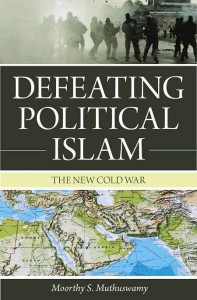|
Reviewed by Wyndham Whynot, Ph.D., Assistant Professor of History, Livingstone College. In the aftermath of Al-Qaeda’s September 11, 2001 attacks on the United States and other terrorist strikes motivated by radical Islam against U.S. interests and allies, the American military has actively engaged in operations in Afghanistan, Iraq, and against al-Qaeda and their followers throughout the world. Moorthy Muthuswamy argues that America faces a new “Cold War,” only this time the enemy, instead of the Soviet Union, is the “axis of jihad,” referring to Saudi Arabia, Pakistan, and Iran. (p. 12) Muthuswamy details this argument and his prescriptions for winning this modern “Cold War” in his newest book, Defeating Political Islam: The New Cold War. While a nuclear physicist by trade, Dr. Muthuswamy has written a number of articles and columns focusing on Islamic fundamentalism and the role of Islamic-based terrorism throughout the world; some of which are incorporated into his book. At first glance Defeating Political Islam appears to be an original work detailing the rise of fundamentalist Islam in India and in other areas of the world; however, significant portions of this book actually appear in his formerly self-published book The Art of War on Terror: Triumphing over Political Islam and the Axis of Jihad, in 2007, something which Muthuswamy fails to note. Muthuswamy divides his work into four sections, a preliminary section discussing the state of political Islam during the last decade, followed by sections dealing with Islamic expansion since the founding of the religion, the role of jihad in Islamic expansion and methods non-Islamic states might use to deal with the threats of political Islam. Not one to mince words, Muthuswamy takes to task the views expressed by some western political leaders that allowing Islamic religious institutions to participate in democratic nation building would enable Islamic nations to move forward. Instead, he contends that political Islam is contradictory to democracy and argues, as an example of the flaws to this line of thinking, that opening the process to Islamic religious institutions in Iraq was a strategic error. Muthuswamy treats Islamic conquest and jihad as separate chapters, but they could easily have been combined into one section. The author states that Bill Warner’s analysis of violence directed towards non-believers in the Koran indicates that Islam is geared towards engaging in violent conflicts with non-Muslims. Muthuswamy believes various factors provide reasonable doubts about the authenticity of the Koran, Hadiths, and Sira arguing that one reason is the time between the original revelation and the time of publication possibly resulted in errors. Other than these elements, little original material is covered in this chapter. However, this book shines in its coverage of political Islam’s attempt to use both jihad and increased Muslim birthrates/populations to gain political control in parts of India, and potentially in more regions in the future. Approximately forty percent of this book examines possible methods western-style democracies might use to restrict the expansion of political Islam and to possibly destroy the effectiveness of the “axis of jihad.” He points out that western-style democracies have not only failed to confront political Islam at home and abroad, but have actually adopted policies which have increased the effectiveness of the Islamic threat. He argues that fighting Islamic expansion requires that governments seriously reappraise the actual threat and implement policies such as issuing propaganda to counter information coming from the mosques; forced relocations of Muslims to their homelands; lawsuits against Saudi Arabia and Iran; and limited military strikes against the “axis of jihad,” especially in dealing with Iran. Constitutional issues, human rights issues, and human nature make some of the author’s proposals either unfeasible in today’s environment (such as forced relocation or military action) or feasible only on a very long-term basis (considering, for example, lawsuits or propaganda strategy, which will take years to be effective). Individuals interested in an in-depth look at the history of Islam’s political/military expansion will be disappointed, since much information is essentially glossed over. Musthuswamy, however, does provide readers much to consider in terms of analyzing some responses to political Islam. Arguably among the stronger points of the book is its focus on Islam’s role in South Asia—especially India. Discussions about other regions, such as the United States, Europe, and Israel, receive less attention, while Islam’s presence in Africa receives very limited attention, but Muthuswamy’s analysis of India’s governmental policies towards political Islam within the country is excellent. Notwithstanding the aforementioned criticisms, as well as the lack of an index and a few typographical errors, the book is well written and recommended as an interesting counterpoint to some of the more recent apologist views presented in academic literature and the media. |


 Defeating Political Islam: The New Cold War
Defeating Political Islam: The New Cold War